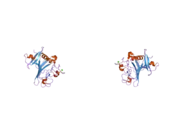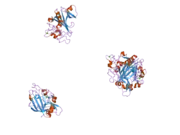ANGPT2
Angiopoietin-2 is a protein that in humans is encoded by the ANGPT2 gene.[5]
Naturally occurring antagonist for both ANGPT1 and TIE2; expressed only at the sites of vascular remodeling; similar to angiopoietin-1[6]
Function
Interactions
ANGPT2 has been shown to interact with TEK tyrosine kinase.[7][8][9]
See also
References
- GRCh38: Ensembl release 89: ENSG00000091879 - Ensembl, May 2017
- GRCm38: Ensembl release 89: ENSMUSG00000031465 - Ensembl, May 2017
- "Human PubMed Reference:". National Center for Biotechnology Information, U.S. National Library of Medicine.
- "Mouse PubMed Reference:". National Center for Biotechnology Information, U.S. National Library of Medicine.
- Cheung AH, Stewart RJ, Marsden PA (March 1998). "Endothelial Tie2/Tek ligands angiopoietin-1 (ANGPT1) and angiopoietin-2 (ANGPT2): regional localization of the human genes to 8q22.3-q23 and 8p23". Genomics. 48 (3): 389–91. doi:10.1006/geno.1997.5207. PMID 9545648.
- "Entrez Gene: ANGPT2 angiopoietin 2".
- Fiedler U, Krissl T, Koidl S, Weiss C, Koblizek T, Deutsch U, Martiny-Baron G, Marmé D, Augustin HG (January 2003). "Angiopoietin-1 and angiopoietin-2 share the same binding domains in the Tie-2 receptor involving the first Ig-like loop and the epidermal growth factor-like repeats". The Journal of Biological Chemistry. 278 (3): 1721–7. doi:10.1074/jbc.M208550200. PMID 12427764.
- Sato A, Iwama A, Takakura N, Nishio H, Yancopoulos GD, Suda T (August 1998). "Characterization of TEK receptor tyrosine kinase and its ligands, Angiopoietins, in human hematopoietic progenitor cells". International Immunology. 10 (8): 1217–27. doi:10.1093/intimm/10.8.1217. PMID 9723709.
- Maisonpierre PC, Suri C, Jones PF, Bartunkova S, Wiegand SJ, Radziejewski C, Compton D, McClain J, Aldrich TH, Papadopoulos N, Daly TJ, Davis S, Sato TN, Yancopoulos GD (July 1997). "Angiopoietin-2, a natural antagonist for Tie2 that disrupts in vivo angiogenesis". Science. 277 (5322): 55–60. doi:10.1126/science.277.5322.55. PMID 9204896.
External links
- Human ANGPT2 genome location and ANGPT2 gene details page in the UCSC Genome Browser.
Further reading
- Maisonpierre PC, Suri C, Jones PF, Bartunkova S, Wiegand SJ, Radziejewski C, Compton D, McClain J, Aldrich TH, Papadopoulos N, Daly TJ, Davis S, Sato TN, Yancopoulos GD (July 1997). "Angiopoietin-2, a natural antagonist for Tie2 that disrupts in vivo angiogenesis". Science. 277 (5322): 55–60. doi:10.1126/science.277.5322.55. PMID 9204896.
- Sato A, Iwama A, Takakura N, Nishio H, Yancopoulos GD, Suda T (August 1998). "Characterization of TEK receptor tyrosine kinase and its ligands, Angiopoietins, in human hematopoietic progenitor cells". International Immunology. 10 (8): 1217–27. doi:10.1093/intimm/10.8.1217. PMID 9723709.
- Tanaka S, Mori M, Sakamoto Y, Makuuchi M, Sugimachi K, Wands JR (February 1999). "Biologic significance of angiopoietin-2 expression in human hepatocellular carcinoma". The Journal of Clinical Investigation. 103 (3): 341–5. doi:10.1172/JCI4891. PMC 407900. PMID 9927494.
- Valenzuela DM, Griffiths JA, Rojas J, Aldrich TH, Jones PF, Zhou H, McClain J, Copeland NG, Gilbert DJ, Jenkins NA, Huang T, Papadopoulos N, Maisonpierre PC, Davis S, Yancopoulos GD (March 1999). "Angiopoietins 3 and 4: diverging gene counterparts in mice and humans". Proceedings of the National Academy of Sciences of the United States of America. 96 (5): 1904–9. doi:10.1073/pnas.96.5.1904. PMC 26709. PMID 10051567.
- Grosios K, Leek JP, Markham AF, Yancopoulos GD, Jones PF (1999). "Assignment of ANGPT4, ANGPT1, and ANGPT2 encoding angiopoietins 4, 1 and 2 to human chromosome bands 20p13, 8q22.3-->q23 and 8p23.1, respectively, by in situ hybridization and radiation hybrid mapping". Cytogenetics and Cell Genetics. 84 (1–2): 118–20. doi:10.1159/000015235. PMID 10343124. S2CID 40232421.
- Procopio WN, Pelavin PI, Lee WM, Yeilding NM (October 1999). "Angiopoietin-1 and -2 coiled coil domains mediate distinct homo-oligomerization patterns, but fibrinogen-like domains mediate ligand activity". The Journal of Biological Chemistry. 274 (42): 30196–201. doi:10.1074/jbc.274.42.30196. PMID 10514510.
- Kim I, Kim JH, Ryu YS, Jung SH, Nah JJ, Koh GY (June 2000). "Characterization and expression of a novel alternatively spliced human angiopoietin-2". The Journal of Biological Chemistry. 275 (24): 18550–6. doi:10.1074/jbc.M910084199. PMID 10766762.
- Mezquita J, Mezquita P, Montserrat P, Mezquita B, Francone V, Vilagrasa X, Mezquita C (August 2000). "Genomic structure and alternative splicing of chicken angiopoietin-2". Biochemical and Biophysical Research Communications. 275 (2): 643–51. doi:10.1006/bbrc.2000.3345. PMID 10964717.
- Xu Y, Yu Q (September 2001). "Angiopoietin-1, unlike angiopoietin-2, is incorporated into the extracellular matrix via its linker peptide region". The Journal of Biological Chemistry. 276 (37): 34990–8. doi:10.1074/jbc.M103661200. PMID 11447223.
- Acker T, Beck H, Plate KH (October 2001). "Cell type specific expression of vascular endothelial growth factor and angiopoietin-1 and -2 suggests an important role of astrocytes in cerebellar vascularization". Mechanisms of Development. 108 (1–2): 45–57. doi:10.1016/S0925-4773(01)00471-3. PMID 11578860. S2CID 18841951.
- Ward EG, Grosios K, Markham AF, Jones PF (2002). "Genomic structures of the human angiopoietins show polymorphism in angiopoietin-2". Cytogenetics and Cell Genetics. 94 (3–4): 147–54. doi:10.1159/000048807. PMID 11856872. S2CID 22445942.
- Huang YQ, Li JJ, Hu L, Lee M, Karpatkin S (March 2002). "Thrombin induces increased expression and secretion of angiopoietin-2 from human umbilical vein endothelial cells". Blood. 99 (5): 1646–50. doi:10.1182/blood.V99.5.1646. PMID 11861279.
- Hata K, Udagawa J, Fujiwaki R, Nakayama K, Otani H, Miyazaki K (2002). "Expression of angiopoietin-1, angiopoietin-2, and Tie2 genes in normal ovary with corpus luteum and in ovarian cancer". Oncology. 62 (4): 340–8. doi:10.1159/000065066. PMID 12138242. S2CID 40689314.
- Lin S, Shyu KG, Lee CC, Wang BW, Chang CC, Liu YC, Huang FY, Chang H (August 2002). "Hyperbaric oxygen selectively induces angiopoietin-2 in human umbilical vein endothelial cells". Biochemical and Biophysical Research Communications. 296 (3): 710–5. doi:10.1016/S0006-291X(02)00924-5. PMID 12176040.
- Geva E, Ginzinger DG, Zaloudek CJ, Moore DH, Byrne A, Jaffe RB (September 2002). "Human placental vascular development: vasculogenic and angiogenic (branching and nonbranching) transformation is regulated by vascular endothelial growth factor-A, angiopoietin-1, and angiopoietin-2". The Journal of Clinical Endocrinology and Metabolism. 87 (9): 4213–24. doi:10.1210/jc.2002-020195. PMID 12213874.
- Paradis V, Bièche I, Dargère D, Laurendeau I, Nectoux J, Degott C, Belghiti J, Vidaud M, Bedossa P (March 2003). "A quantitative gene expression study suggests a role for angiopoietins in focal nodular hyperplasia". Gastroenterology. 124 (3): 651–9. doi:10.1053/gast.2003.50104. PMID 12612904.
This article incorporates text from the United States National Library of Medicine, which is in the public domain.
This article is issued from Wikipedia. The text is licensed under Creative Commons - Attribution - Sharealike. Additional terms may apply for the media files.









